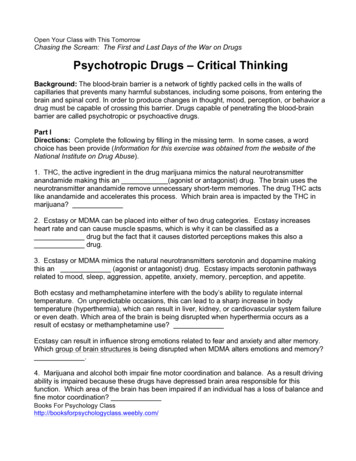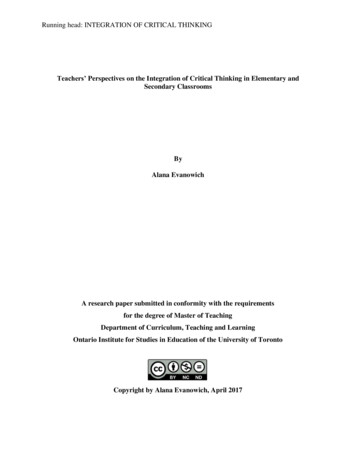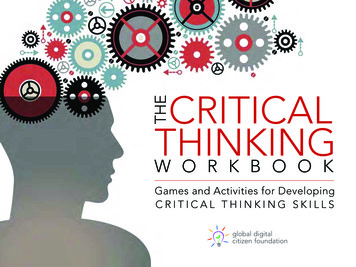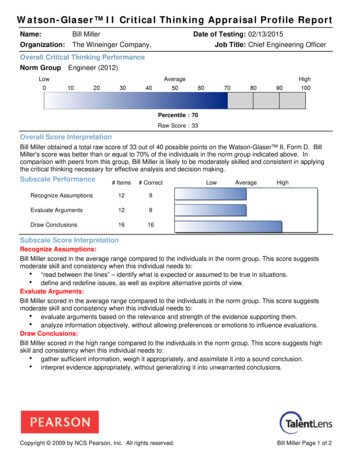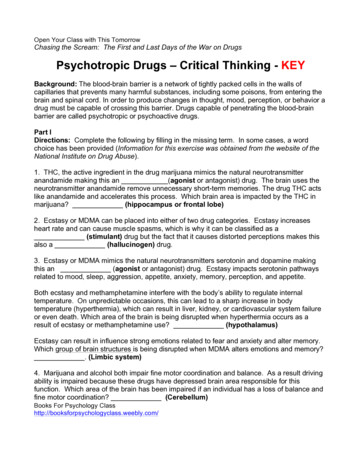
Transcription
Open Your Class with This TomorrowChasing the Scream: The First and Last Days of the War on DrugsPsychotropic Drugs – Critical Thinking - KEYBackground: The blood-brain barrier is a network of tightly packed cells in the walls ofcapillaries that prevents many harmful substances, including some poisons, from entering thebrain and spinal cord. In order to produce changes in thought, mood, perception, or behavior adrug must be capable of crossing this barrier. Drugs capable of penetrating the blood-brainbarrier are called psychotropic or psychoactive drugs.Part IDirections: Complete the following by filling in the missing term. In some cases, a wordchoice has been provided (Information for this exercise was obtained from the website of theNational Institute on Drug Abuse).1. THC, the active ingredient in the drug marijuana mimics the natural neurotransmitteranandamide making this an (agonist or antagonist) drug. The brain uses theneurotransmitter anandamide remove unnecessary short-term memories. The drug THC actslike anandamide and accelerates this process. Which brain area is impacted by the THC inmarijuana? (hippocampus or frontal lobe)2. Ecstasy or MDMA can be placed into either of two drug categories. Ecstasy increasesheart rate and can cause muscle spasms, which is why it can be classified as a(stimulant) drug but the fact that it causes distorted perceptions makes thisalso a (hallucinogen) drug.3. Ecstasy or MDMA mimics the natural neurotransmitters serotonin and dopamine makingthis an (agonist or antagonist) drug. Ecstasy impacts serotonin pathwaysrelated to mood, sleep, aggression, appetite, anxiety, memory, perception, and appetite.Both ecstasy and methamphetamine interfere with the body’s ability to regulate internaltemperature. On unpredictable occasions, this can lead to a sharp increase in bodytemperature (hyperthermia), which can result in liver, kidney, or cardiovascular system failureor even death. Which area of the brain is being disrupted when hyperthermia occurs as aresult of ecstasy or methamphetamine use? (hypothalamus)Ecstasy can result in influence strong emotions related to fear and anxiety and alter memory.Which group of brain structures is being disrupted when MDMA alters emotions and memory?. (Limbic system)4. Marijuana and alcohol both impair fine motor coordination and balance. As a result drivingability is impaired because these drugs have depressed brain area responsible for thisfunction. Which area of the brain has been impaired if an individual has a loss of balance andfine motor coordination? (Cerebellum)Books For Psychology Classhttp://booksforpsychologyclass.weebly.com/
5. When individuals are under the influence of alcohol they are less inhibited because theareas of the brain responsible for decision-making, reason, planning, and risk evaluation aredepressed. Which area of the brain is being slowed down as a result of alcohol causing thesecognitive and behavioral changes? (Frontal lobe or Pre-frontal cortex)6. Individuals who are under the influence of cocaine experience elevated heart andrespiratory rates that can become life threatening. Which are of the brain is causing thesephysiological changes? (Medulla; Hindbrain) In which drug category shouldcocaine be classified? (Stimulant)7. Individuals who abuse steroids, methamphetamine or prescription stimulants mayexperience high levels of anxiety and hostility by affecting many different parts of the brain,including the , which is a subcortical structure that controls strong emotions.(Amygdala)8. Although the various drugs classified as CNS depressants work differently, they all have acalming or drowsiness-inducing effect because they increase the transmission of the majorinhibitory neurotransmitter , (GABA) which is why some are used for sleepdisturbances and anxiety. CNS depressants increase the transmission of a particularneurotransmitter making them (agonist or antagonist) drugs.9. Drugs (such as opioids) with addictive properties work on the reward pathway in the brain byincreasing transmission of the pleasure producing neurotransmitter(Dopamine) and the body’s natural pain relieving neurotransmitter(Endorphins).10. Individuals under the influence of cocaine may experience surges of adrenaline due to theoverstimulation of the part of the brain responsible for regulating the fight or flight response.The result can be hyper-alertness, paranoia, and aggression. What area of the brain controlsthe fight or flight reaction? (Hypothalamus)11. Individuals sometimes find that the day after drinking alcohol that they cannot recall someor all of the events that occurred when they were drinking. Which brain structure that isresponsible for encoding new memories was likely not functioning due to the depressantalcohol? (Hippocampus)12. Which area of the hindbrain is impaired when heroin or alcohol depresses the area of thebrain responsible for heart rate and breathing? (Medulla)Books For Psychology Classhttp://booksforpsychologyclass.weebly.com/
Psychotropic Drugs – Critical ThinkingPart IIDirections: Listed below are several brain parts. For each brain part listed, indicate how anindividual’s behavior might be changed if a psychotropic drug crossed the blood brain barrierand impacted that brain part. You may use the same drug more than one time.Use at least one drug from each of the following categories: Depressant Stimulant OpioidExample: Reticular FormationSpecific Drug: HeroinDrug Category: Depressant (Opioid)Responsibility of Brain area: Plays a role in alertness and arousalImpact on behavior: When heroin crosses the blood-brain barrier to impact the reticularformation the result can be an individual losing consciousness because the reticular formationis responsible for arousal.Books For Psychology Classhttp://booksforpsychologyclass.weebly.com/
Brain AreaSpecificDrugDrugResponsibility of Impact onCategory Brain AreaBehaviorNucleusAccumbensParietal LobeCerebellumPrefrontalCortexTemporal LobeHippocampusBooks For Psychology ation in Brain
Brain AreaSpecificDrugDrugResponsibility of Impact onCategory Brain AreaBehaviorMedullaBroca’s AreaOccipital LobeAmygdalaHypothalamusBooks For Psychology ation in Brain
Chasing the Scream: The First and Last Days of the War on Drugs Psychotropic Drugs – Critical Thinking - KEY Background: The blood-brain barrier is a network of tightly packed cells in the walls of capillaries that prevents many harmful substances, includi


